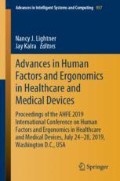Abstract
The process of innovation in the design of medical devices is complex. The analysis of the user, the disease stage of the patient and the fact that all clinical histories are different generates a series of variables that are a challenge for any Medical Device designer. The traditional industrial design uses frameworks to control information and visualize future scenarios to understand the user experience; this allows the designer to anticipate behaviour and design the object according to the needs of the users. Industrial design framework and medical device design framework differ significantly since the design of medical devices requires the analysis of multi-frameworks for a single object. This generates a very complex brief for any designer. This theoretical work argues that prior knowledge of the multi-framework in the design process of medical devices might help the designer to visualize the spectrum of the problem and focuses its efforts on reducing frames.
Access this chapter
Tax calculation will be finalised at checkout
Purchases are for personal use only
References
Wiggermann, N., et al.: Human-centered design process for a hospital bed: promoting patient safety and ease of use. Ergon. Des. Q. Hum. Factors Appl. (2019). https://doi.org/10.1177/1064804618805570
Shah, S.G.S., Robinson, I.: Medical device technologies: who is the user? Int. J. Healthc. Technol. Manag. 9(2), 181 (2008)
Vigna, A., et al.: Manual Práctico para analizar productos en base a escenarios, Buenos Aires, Argentina (2014)
Ariza, R., et al.: Escenarios para pensar el producto (2015)
Kishita, Y., et al.: Scenario design approach to envisioning sustainable manufacturing industries to 2050. Procedia CIRP 48, 407–412 (2016)
White, R.H., et al.: Diffusion of innovation in service organizations. J. Arthroplasty 25(4), 667 (2010)
Trujillo Suárez, M., et al.: Los métodos más característicos del diseño centrado en el usuario -DCU-, adaptados para el desarrollo de productos materiales. Iconofacto. 12(19), 215–236 (2016)
Universidad del Valle: El Modelo De Leavell Y Clark Como Marco Descriptivo Dentro De Las Investigaciones Sobre El Virus De La Hepatitis B En Niños Con Infección Por Vih/Sida Del Grupo De Investigación Gastrohnup. 1, 2015–2018 (2017)
Eilouti, B.: Scenario-based design: new applications in metamorphic architecture. Front. Archit. Res. 7(4), 530–543 (2018)
Vincent, C.J., Blandford, A.: Usability standards meet scenario-based design: challenges and opportunities. J. Biomed. Inform. 53, 243–250 (2015)
Mitchell, R.J., et al.: Application of a human factors classification framework for patient safety to identify precursor and contributing factors to adverse clinical incidents in hospital. Appl. Ergon. 52, 185–195 (2016)
Desmet, P.M.A., Hekkert, P.: Framework of product experience. Int. J. Des. 1(1), 57–66 (2007)
Ward, J.R., et al.: An analysis of medical device-related errors: prevalence and possible solutions 1902 (2009)
ISO: A practical guide ISO 13485 : 2016 Medical devices (2017)
Author information
Authors and Affiliations
Corresponding author
Editor information
Editors and Affiliations
Rights and permissions
Copyright information
© 2020 Springer Nature Switzerland AG
About this paper
Cite this paper
Cortes-Chavez, F., Rossa-Sierra, A., Gonzalez-Muñoz, E.L., Aceves-Gonzalez, C., Manzano-Hernandez, P., Giovanna-Trotta, M. (2020). Multi-frameworks Development for the Medical Device Design Process as a Critical Factor for Innovation. In: Lightner, N., Kalra, J. (eds) Advances in Human Factors and Ergonomics in Healthcare and Medical Devices. AHFE 2019. Advances in Intelligent Systems and Computing, vol 957. Springer, Cham. https://doi.org/10.1007/978-3-030-20451-8_22
Download citation
DOI: https://doi.org/10.1007/978-3-030-20451-8_22
Published:
Publisher Name: Springer, Cham
Print ISBN: 978-3-030-20450-1
Online ISBN: 978-3-030-20451-8
eBook Packages: EngineeringEngineering (R0)

